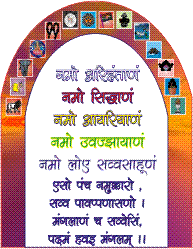

The Navkar Mantra is the most fundamental (mulya) mantra of Jains. There is no particular time of the day to recite it. Any time is a suitable time for the recitation of the Navkar mantra and also any place is suitable, but yes our mind and heart should be pure. It has been considered that while reciting the Navkar Mantra, we bows with respect to all the Arihantas, Siddhas, Ächäryäs, Upädhyäyas, Sädhus, and Sädhvi, and not to any particular one. This enables him to remember virtues of all the supreme spiritual people instead of just one particular person. With each line of the mantra the aspirant makes a way for the impurities in his inner self to move out and virtues of these spiritual people move in. This makes a process to purify himself, at least for that very time period. This mantra is a bow down to these supreme spiritual personalities, and therefore, it is also called Namaskär or Namokär Mantra.
The Navkär Mantra contains the essence of Jainism. It was, is, and will remain the Mulya Mantra of Jainism. Also known as ‘MAHA MANTRA’
Namo Arihantanam:
I bow down to Arihanta, ARIHANTAS (the color of Arihantas is white)
The term Arihanta is made up of Ari, meaning enemies, and hant, meaning destroyer. Consequently, Arihanta means destroyer of enemies. Enemies such as anger, greed, enemies, which defile the true nature of the soul. Only a person with human body can become a Tirthankara. A soul can only reach the state of Arihanta by overcoming all its inner enemies. Arihantas are divided into two categories: Tirthankar and Ordinary. Arihantas who have attained Tirthankar NämKarma become Tirthankaras while the rest of them become Ordinary Arihants. There are twenty-four Tirthankaras during every half time cycle.
Namo Siddhanam:
I bow down to Siddha, SIDDHAS (the color of Siddhas is red) Siddhas are liberated souls.
They have reached the highest state, salvation, and have attained Moksha.
They have paid all dues of their karmas, thus freeing themselves forever from the cycle of birth and death (AkshayaSthiti). This state of freedom is called Moksha.
They know and perceive everything in total that is happening now, that has happened in the past, and that which will happen in the future all at the same time. Here a question can arise "If Siddhas are the highest state then why do we bow to Arihantas first and then to the siddhas" the answer is "we do so because the Siddhas were not present to speak to the people and tell them the right way.
It is the arihantas or the Tirthankaras who tell the people the right way to move to. Arihantas tell about the Siddhas. Without Arihantas nobody can know about the Siddhas. So, being this He is bowed first.
Namo Ayriyanam:
I bow down to Acharya, ACHARYAS (the color of Acharyas is yellow)
our spiritual leaders are called Acharyas. They carry out the message of Jina (Tirthankara). The responsibility of the spiritual welfare of the entire Jain Samaj rests on their shoulders. They are the persons whom the almighty selects themselves.
An in-depth study Jain Agams, having high level of spiritual excellence, ability to lead the monastic communion, knowledge of various languages of the country, a sound knowledge of other philosophies, ideologies, and religions of the region and the world makes a Acharya.
Namo Uvajjhayanam:
I bow down to Upadhyaya, UPADHYAYAS (the color of Upadhyayas is green)
Upadhyayas are those Sädhus who have acquired a special knowledge of the Jain scriptures (Agams). They teach Jain scriptures to deserving aspirants, including sädhus and sädhvis.
Namo Loe Savva-sahunam:
I bow down to Sadhu and Sadhvi. SADHUS AND SADHVIS (their color is dark purple - near to black)
A male person who renounces the worldly life is called a monk or sädhu, and a female is called a nun or sadhvi. This person become detached from the worldly aspects of life (Moah and Maya) and spends entire life in spiritual upliftment. The newly initiated sadhu or sadhvi adopts five major vows:
1) Observance of Ahimsa (non-violence)
2) Observance of Satya (truth)
3) Observance of Asteya (non-stealing))
4) Observance of Brahamcharya (celibacy)
5) Observance of Aparigraha (non-possessiveness)
They do not eat before sunrise or after sunset. They drink only boiled water. They walk bare feet. They do not stay in one place for a longer time. They do not touch any person of opposite sex. They are not a social workers. For a worldly person like you and me this seems a difficult rather an impossible job. This is a reason Jain Sashus and Sadhvis are very rare personalities.
Eso Panch Namokaro: These five bowing downs,
Savva-pavappanasano: Destroy all the sins,
Manglananch Savvesim: Amongst all that is auspicious,
Padhamam Havei Mangalam: This Navkar Mantra is the foremost.
The first five lines are the mantra and next four lines are the result of enchanting the above lines.
and till date nobody can change the pattern of these lines.
Even If we put 'shri' or 'ohm' in between the lines,
Like - 'Ohm namo arihanta nam'
the effect of the mantra gets changed. If one wants to bear the fruits of the
mantra in this very life span, then ‘OHM’ is added.